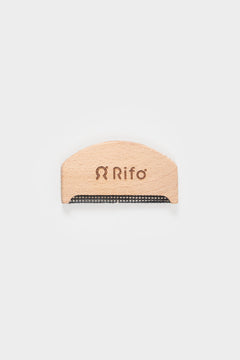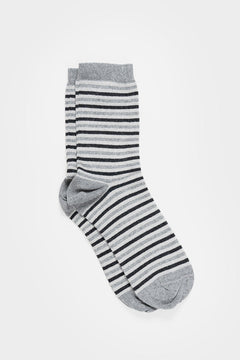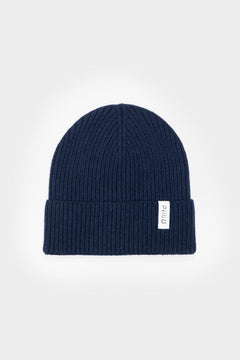It’s that time of the year: it’s time to change our summer wardrobe to winter wardrobe and pull out mid-season and heavy sweaters. From suitcases and vacuum bags come knitwear from previous years: a little wrinkles, a little aged, some covered with little lints on the surface.
Ah, pilling, what a monster… who hasn’t hated and fought it with all their might?
Then one day you realise it’s a losing battle, a tilt at windmills, and no matter how hard you try to remove it, pilling will be back.
So maybe it’s better to come to terms with it and accept the physical limits of things, without always expecting them to be perfect. Actually, we could take the opportunity to ask ourselves a few questions.
We at Rifò have done just that. We questioned ourselves on the ageing of garments and on which fibers are more prone to pilling.
For instance, does recycled cashmere really pill more than virgin cashmere? What is the difference between the pilling of garments that are made from pure, natural materials and those coming from cheap materials with large quantities of acrylic fibers?
A series of considerations that led us to a broader issue, which is crucial for us: which limits are we willing to accept in the name of a more sustainable fashion?
So, with all these questions in mind, we decided to start writing and tell you about our point of view on pilling. Also, we want to give you some advice on how to prevent it.
How does pilling occur?
Let’s first take a step back on the origin of such a phenomenon, because knowing the enemy is the first step in dealing with it.
Pilling, or lint or pills, is nothing but the amount of excess fibre that comes out of the weaving of knitted garments over time. This phenomenon mainly occurs through rubbing, which is why it is much more common on sweaters rather than on beanies. Pills’ natural environment, in fact, is on the bottom part of knitwear or the undersleeve.

The second aspect that leads to “ageing” and pilling is washing. In both washing machines and when hand washing, the fibers are moved and displaced, and the heat of the water also contributes to their swelling.
Pilling and recycled fibers
So, are there any sweaters that don’t pill?
No. Sooner or later they all will, it is an inevitable phenomenon.
In terms of virgin vs. recycled fibers, virgin ones, which are longer and stronger compared to recycled ones, will definitely tend to pill later.
Let’s take cashmere. By producing a clothing collection with recycled cashmere, we face the characteristics of this yarn every day. We of course see its limitations, but we try to overcome them through careful design of the garments, following the principles of eco-design.
From our point of view, a recycled cashmere garment does not very easily pill if it’s designed, treated and engineered correctly. In fact, there are somo production processes that affect pilling, for example the industrial washing of the garment after weaving. In this phase, softeners are added to create the desired texture. The greater the amount of these substances, the softer the garment will be. But at the same time it will be more prone to pilling.

This is exactly why, for Rifò recycled cashmere products, we have chosen not to exaggerate with softeners and chemicals. Because, yes, sometimes accepting a garment with a slightly less soft touch will make it last longer.
Here we go back to the idea of accepting even the “weak” points of what we wear, in order to pay more attention to durability and, above all, sustainability.
So when we’re asked, “Is it true that recycled cashmere makes more pilling?”, for us is natural to say, “No. But even if it is, it isn’t that a fair price to pay to reduce its impact on the planet?”.
The impact of cashmere goats intensive farming to produce virgin yarn is indeed enormous. In Mongolia the devastating effect of this activity is causing a real desertification.
Synthetic or natural materials?
Have you ever bought an acrylic sweater and seen it ruined in its very first wash?
After some thought, we came to the conclusion that one of the first distinctions to make when it comes to pilling is: synthetic or natural material?
If you think about it, in the case of a garment made from synthetic knitting yarns, mainly acrylics, what happens after several washes and with daily use is slightly different from pilling.

The fibers tend to come out of the weaving and stretch, making maintenance with a lint remover comb or a fabric shaver much less durable. As you can see from the photo, the fibers are pulled further out, but not removed.

On the other hand, in the case of a natural fiber such as recycled cashmere, the lints that could appear after several uses have a different structure. They are in fact punctual and can be removed completely with the special lint remover, leaving the surface of the mesh smooth and clean. In the video we can see how with a few steps it is possible to clean a knitted garment with a lot of pilling and get it back in shape.
Preventing and counteracting pilling
Apart from the length of fibers, there are other factors that may or may not favour pilling. So it is good to know them in order to make a better choice for your next garment.
The knitting stitch: a tighter and more compact stitch will hold the fibers more firmly, while a jumper made with a more open and soft stitch will make them looser. This last aspect could bring to a more important presence of lint, even if everything must be contextualised with regard to the quality of the material.

The material: another important aspect to consider is the material. For example, wool has a structure where pilling becomes almost an intrinsic feature, whereas in a cotton sweater this is very unlikely to happen.
Moreover, there are some tricks you can use to take care of your sweater and prevent pilling, e.g.:
- You can reduce washing and not stress the garment. Natural fibers such as wool need far fewer washes over a season when compared to synthetic fibers.
- You can use a detergent with a neutral pH, which reduces swelling of the fibers during ashing.
Last but not least, the most effective solution of all: remove pilling with a special comb!
Our Johnny, for example, is a gentle but still effective tool and works without the need of any batteries.

Planned obsolescence or just the normal course of time: how to recognise them
In summary, choosing natural fibers such as wool and cashmere will make the care and maintenance of a sweater easier and more durable over time, even if pills will inevitably show up.
Unfortunately, fast fashion has not trained us to think in the long term, but to almost single use consuming habits. Therefore, we’ve got used to changing clothes at the speed of light, not thinking about their impact on the planet. We have become more and more demanding, always claiming to wear something new, something flawless. No matter if it is a single use garment.
Question is: are we still able to recognize quality?
When looking at different two-year-old sweaters, one made of pure wool and the other 100% acrylic, could you tell the difference between planned obsolescence and the natural course of time?
This is the exercise we have to get into practice if we really want to start buying clothes that will last in the wardrobe, clothes that tell our story.
We need to develop a critical sense, touch the materials, look at the labels and recognize what is quality from what is not. In the end, it’s also important to accept the physical limits of objects and the fascination that time can bring on them.
This is why we ask ourselves: does it make sense in the name of sustainability to accept a little pilling?
We believe so, and you? What do you think? Write us in the comments.
Rifò is carrying on this very idea, through its communication and through a collection of garments made from sustainable, recycled and durable materials. Want to discover them?
Join the #Rifolution!








